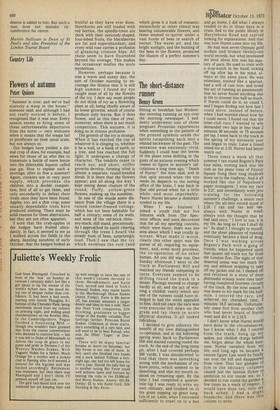Country Life
Flowers of autumn
Peter Quince
"Summer is over, and we've had scarcely a wasp in the house," someone said; and although I had not really noticed it before, I recognised that it was true. Every season seems to bring some of these unforeseeable departures from the norm — very welcome when it means that the wasps fail to proliferate on their usual scale, but not always so.
Our hedges have yielded a dismal crop of sloes, for example, bad news for those of us who like to transmute a bottle of mere booze into the delectable liqueur called sloe gin. How to explain such a shortage, after so fine a summer? Again, conkers are in very poor supply, which provokes the children into a double competition, first of all to get them, and only secondarily to defeat their rivals once they have been found. Apples, too, are a thin crop; some usually dependable trees have produced nothing. There must be solid reasons for these aberrations, but they are not often apparent. I note that the crab-apples in the hedges have fruited abundantly. In fact, it seemed to me as I walked across the fields in the sharp, dazzling sunshine of early October, that the hedges looked as fruitful as they have ever done. Hawthorns are still loaded with red berries, the spindle-trees are thick with their curiously-shaped, four-lobed fruits, the blackberries are fat and superabundant, and every wild rose carries a profusion of gleaming crimson hips. All these seem to have flourished beyond the average. This makes the occasional misfire the more mysterious.
However, perhaps because it was a warm and sunny day, the sort of October morning to encourage the illusion that it is still high summer, I found my eye caught most of all by the flowers of the ivy. I dare say most people do not think of ivy as a flowering plant at all, being chiefly aware of its lower growths, which of course produce only leaves. But it does flower, and at this time of year, moreover, when there is not much competition. This autumn, it is doing so in riotous profusion.
The growth of the ivy is strange. When it has reached the top of whatever it is clinging to, whether it be a wall, or a bank of earth, or a tree, and has reached the full light, it undergoes a change of character. The tendrils cease to reach out, and short, stiffer growths develop, forming what is almost a separate, round-headed shrub. It is there that the flowers appear; and all along the way I kept seeing dense clusters of the round, fluffy, yellow-green flowers, soaking up the sunshine.
In one of the woods some distance from the village there is a ruined timber-framed cottage, which has not been habitable for half a century; some of its walls, and most of the red-brick chimney-stack, still stand, precariously. As I approached its sunlit clearing through the trees I heard the steady hum of bees, surprisingly loud. Then I saw that the ivy which envelops the ruin (and which gives it a look of romantic melancholy at other times) was bearing innumerable flowers, and these seemed to 'quiver under a vast horde of bees in search of nectar. The warm air, and the bright sunlight, and the buzzing of the bees in the flowers, produced the illusion of a perfect summer's day.


































 Previous page
Previous page